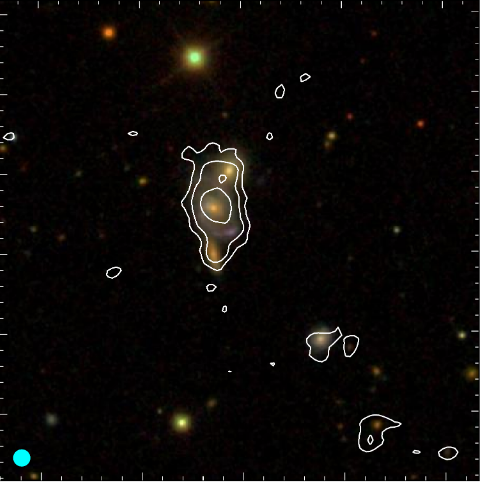Astronomy Object of the Month: 2019, March
< previous Archive next >
Compact galaxy groups observed with LOFAR radio interferometer
LOFAR Two-metre Sky Survey (LoTSS) has detected
thousands of new galaxies. International team — including scientists from the Astronomical Observatory of the
Jagiellonian University — used this survey to identify the groups of galaxies from the
Hickson Compact Groups and
Magnitude Limited Compact Groups samples that emit at the low radio frequency of 150 MHz. Their radio emission was then
characterised and the newly obtained results were compared to earlier observations and theoretical predictions for the groups.

Illustration 1: Distant and angularly small, exemplary galaxy group: MLCG1374, the ’Wristwatch’. Credit: the Authors/SDSS survey.
Galaxy groups — systems where only a few galaxies are gravitationally bound together, contrary to the more abundant clusters — are believed to be so common in the Universe that it is likely that most of the existing galaxies reside inside them. Groups were originally expected to express physical conditions similar to the central regions of rich clusters, but it was later found that there are actually more differences between these two classes. Groups are not as depleted of neutral hydrogen as clusters are and form stars more vigorously. Furthermore, there is a deficiency of "normal" star forming galaxies inside the groups, while both "dead" and starbursting galaxies are common. The same behavior is seen neither in field galaxies, nor in galaxies located in the clusters.. Numerical simulations also revealed that none of the hydrostatic laws can be scaled from clusters down to the groups owing to a breakdown in the relations that describe these laws.
Contrary to the case of galaxies or galaxy clusters, properties of radio emission and magnetic fields of galaxy groups are still scarcely studied. An early study of the radio emission from a subset of so-called Hickson Compact Groups (1982) showed that extended radio structure only in one system, HCG 60, that was mainly due to the presence of a radio galaxy. Some works considered the active galactic nuclei (AGN) role and feedback, not the existence of magnetic fields inside. However, magnetic fields seem to possess enough energy to be non-negligible agents in the dynamics and evolution of their host systems.
Studies on the radio emission of groups are also of high importance because of the uniqueness of the environment. A plenitude of phenomena that are usually not seen in field galaxies, such as morphological distortions or starburst activity, can be found in these objects. Also, amplification of magnetic field in interacting galaxies has been up to date shown for galaxy pairs but not for groups, where the interaction history is likely to be more complicated.
Gathering a larger sample of test groups is of high interest especially at lower radio frequencies, where the thermal contribution is expected to be negligible and the low-energy relativistic electron population can still be discovered. Typical structures that are expected to be found in the intragroup space share numerous similarities with intergalactic filaments or tails — structures that LOFAR has already revealed in clusters and single objects — so it was expected that surveying radio-emitting galaxy groups at LOFAR metrewaves with this instrument should be possible.
The team showed that it is possible to conduct deep, high fidelity radio observations of galaxy groups also at very low radio frequencies covered by LOFAR telescope. The detection of at least 73 galaxy groups out of 120, of which as many as 17 show the presence of extended radio structures (signifying the presence of intergalactic magnetic fields), confirms the previous hypothesis of the common character of the magnetic field inside galaxy groups and its detectability.
In order to investigate the future potential of low-frequency radio studies of galaxy groups, the team also presented a more detailed insight into four radio-emitting systems, for which the strength of the magnetic field inside their intergalactic medium is calculated. The estimated values are comparable to that found inside star-forming galaxies, suggesting a dynamical and evolutionary importance of the magnetic field in galaxy groups. Compared to the higher frequency observations, LoTSS data for the above four systems show similar or larger extent in the radio continuum, while the accuracy in portraying the small-scale structures is on a comparable, or higher level, providing a unique chance to disentangle particular radio emitters from their surroundings.
Original publication: Exploring the properties of low-frequency radio emission and magnetic fields in a sample of compact galaxy groups using the LOFAR Two-Metre Sky Survey (LoTSS), B. Nikiel-Wroczyński et al. Astronomy and Astrophysics).
The research was conducted at the Departments of Radioastronomy and Space Physics and Stellar and Extragalactic Astronomy of the Jagiellonian University’s Astronomical Observatory (OAUJ). The work was supported by the Polish National Science Centre through the grant UMO-2016/23/D/ST9/00386. The research team from OAUJ included: Błażej Nikiel-Wroczyński, Krzysztof Chyży and Marek Jamrozy.
|
Błażej Nikiel-Wroczyński Astronomical Observatory Jagiellonian University Blazej.Nikiel_Wroczynski [at] uj.edu.pl |


